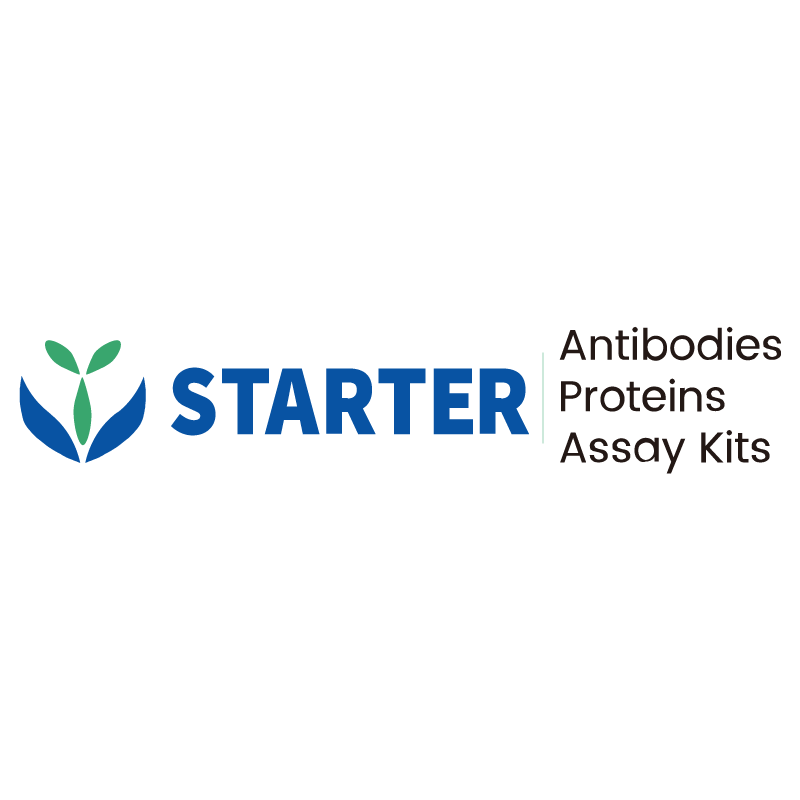WB result of CRALBP Rabbit pAb
Primary antibody: CRALBP Rabbit pAb at 1/1000 dilution
Lane 1: SK-MEL-2 whole cell lysate 20 µg
Lane 2: SK-MEL-28 whole cell lysate 20 µg
Secondary antibody: Goat Anti-Rabbit IgG, (H+L), HRP conjugated at 1/10000 dilution Predicted MW: 36 kDa
Observed MW: 36 kDa
Product Details
Product Details
Product Specification
| Host | Rabbit |
| Antigen | CRALBP |
| Synonyms | Retinaldehyde-binding protein 1; Cellular retinaldehyde-binding protein; RLBP1 |
| Immunogen | Synthetic Peptide |
| Location | Cytoplasm |
| Accession | P12271 |
| Antibody Type | Polyclonal antibody |
| Isotype | IgG |
| Application | WB, IHC-P, ICC, IF |
| Reactivity | Hu, Ms, Rt |
| Positive Sample | SK-MEL-2, SK-MEL-28, mouse eye, rat eye |
| Predicted Reactivity | Bv |
| Purification | Immunogen Affinity |
| Concentration | 0.5 mg/ml |
| Conjugation | Unconjugated |
| Physical Appearance | Liquid |
| Storage Buffer | PBS, 40% Glycerol, 0.05% BSA, 0.03% Proclin 300 |
| Stability & Storage | 12 months from date of receipt / reconstitution, -20 °C as supplied |
Dilution
| application | dilution | species |
| WB | 1:1000 | Hu, Ms, Rt |
| IHC-P | 1:1000 | Ms, Rt |
| ICC | 1:500 | Hu, Ms, Rt |
| IF | 1:1000 | Ms, Rt |
Background
CRALBP, which stands for Cellular Retinaldehyde-Binding Protein, is a protein that plays a critical role in the visual cycle, particularly in the regeneration of 11-cis-retinal for use in rod visual pigments such as opsin and rhodopsin. It is expressed in the retinal pigment epithelium (RPE) and Müller glia (MG) and is essential for maintaining visual function. CRALBP binds to 11-cis-retinol in the visual cycle, thereby augmenting the activity of retinoid isomerohydrolase RPE65 and facilitating the oxidation of 11-cis-retinol to 11-cis-retinal. This process is vital for the photoisomerization of 11-cis-retinal to all-trans-retinal, which is a key step in the visual cycle. In terms of therapeutic implications, gene therapy targeting the RLBP1 gene, which encodes CRALBP, has shown promise in preclinical studies. For instance, gene therapy with adeno-associated viral (AAV) vectors expressing a corrected RLBP1 gene (AAV8-RLBP1) has been shown to restore CRALBP levels and improve dark adaptation in Rlbp1-deficient mice. This suggests potential for treating retinal dystrophies associated with CRALBP dysfunction.
Picture
Picture
Western Blot
WB result of CRALBP Rabbit pAb
Primary antibody: CRALBP Rabbit pAb at 1/1000 dilution
Lane 1: mouse eye lysate 20 µg
Secondary antibody: Goat Anti-Rabbit IgG, (H+L), HRP conjugated at 1/10000 dilution Predicted MW: 36 kDa
Observed MW: 36 kDa
WB result of CRALBP Rabbit pAb
Primary antibody: CRALBP Rabbit pAb at 1/1000 dilution
Lane 1: rat eye lysate 20 µg
Secondary antibody: Goat Anti-Rabbit IgG, (H+L), HRP conjugated at 1/10000 dilution Predicted MW: 36 kDa
Observed MW: 36 kDa
Immunohistochemistry
IHC shows positive staining in paraffin-embedded mouse retina. Anti-CRALBP antibody was used at 1/1000 dilution, followed by a HRP Polymer for Mouse & Rabbit IgG (ready to use). Counterstained with hematoxylin. Heat mediated antigen retrieval with Tris/EDTA buffer pH9.0 was performed before commencing with IHC staining protocol.
IHC shows positive staining in paraffin-embedded rat retina. Anti-CRALBP antibody was used at 1/1000 dilution, followed by a HRP Polymer for Mouse & Rabbit IgG (ready to use). Counterstained with hematoxylin. Heat mediated antigen retrieval with Tris/EDTA buffer pH9.0 was performed before commencing with IHC staining protocol.
Immunocytochemistry
ICC shows positive staining in SK-MEL-28 cells. Anti- CRALBP antibody was used at 1/500 dilution (Green) and incubated overnight at 4°C. Goat polyclonal Antibody to Rabbit IgG - H&L (Alexa Fluor® 488) was used as secondary antibody at 1/1000 dilution. The cells were fixed with 100% ice-cold methanol and permeabilized with 0.1% PBS-Triton X-100. Nuclei were counterstained with DAPI (Blue). Counterstain with tubulin (Red).
Immunofluorescence
IF shows positive staining in paraffin-embedded mouse retina. Anti-CRALBP antibody was used at 1/1000 dilution (Green) and incubated overnight at 4°C. Goat polyclonal Antibody to Rabbit IgG - H&L (Alexa Fluor® 488) was used as secondary antibody at 1/1000 dilution. Counterstained with DAPI (Blue). Heat mediated antigen retrieval with EDTA buffer pH9.0 was performed before commencing with IF staining protocol.
IF shows positive staining in paraffin-embedded rat retina. Anti-CRALBP antibody was used at 1/1000 dilution (Green) and incubated overnight at 4°C. Goat polyclonal Antibody to Rabbit IgG - H&L (Alexa Fluor® 488) was used as secondary antibody at 1/1000 dilution. Counterstained with DAPI (Blue). Heat mediated antigen retrieval with EDTA buffer pH9.0 was performed before commencing with IF staining protocol.


